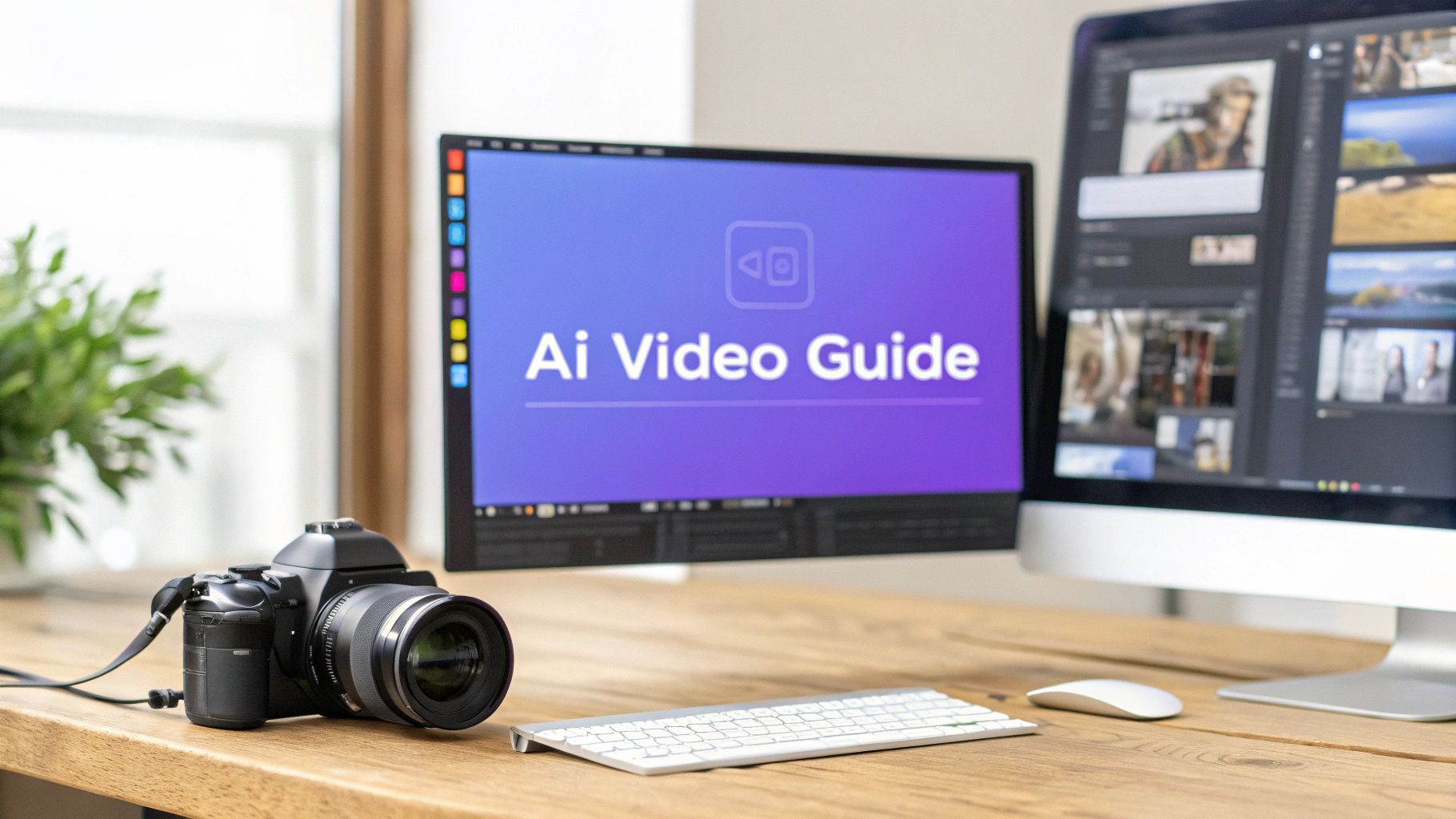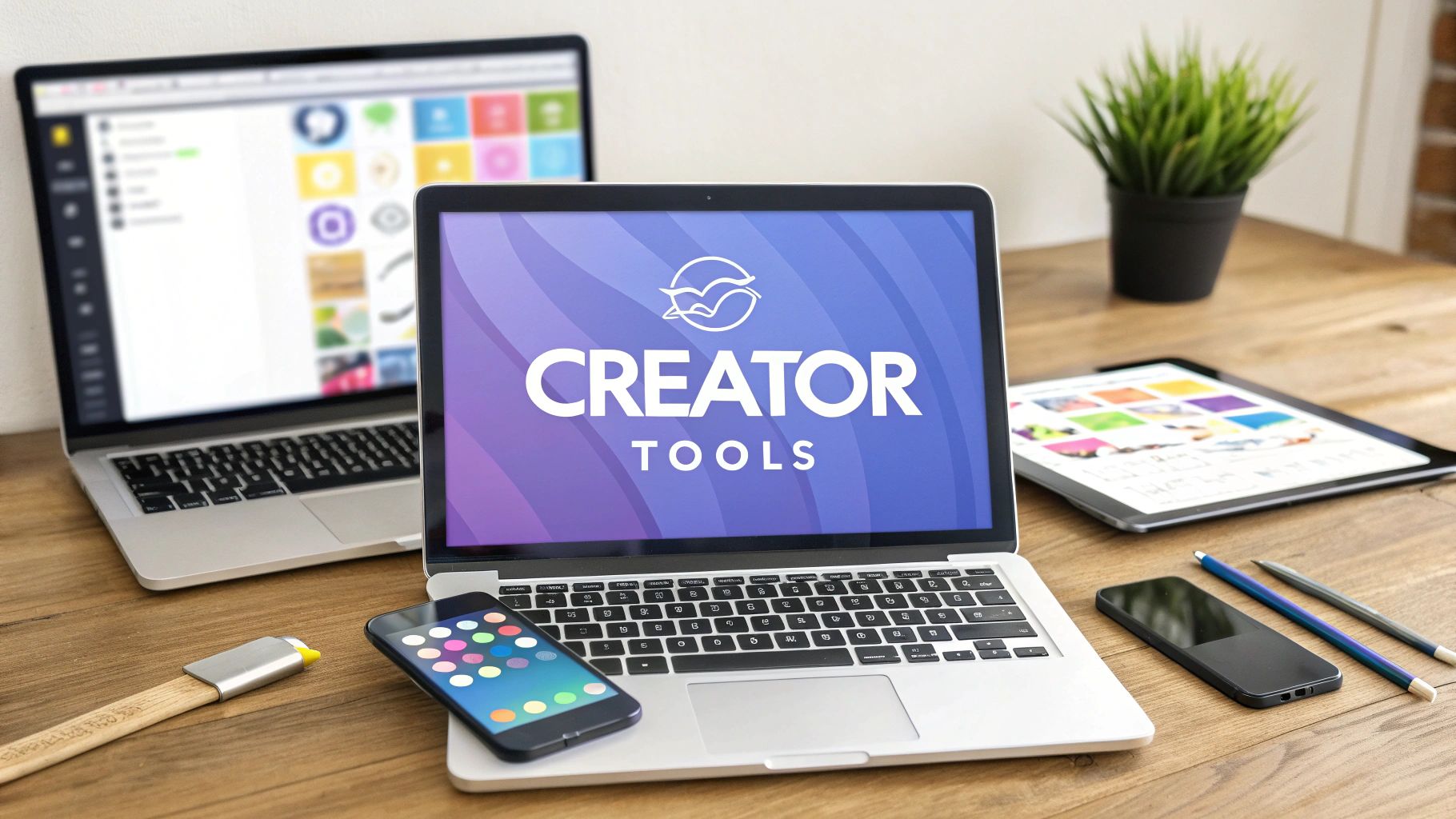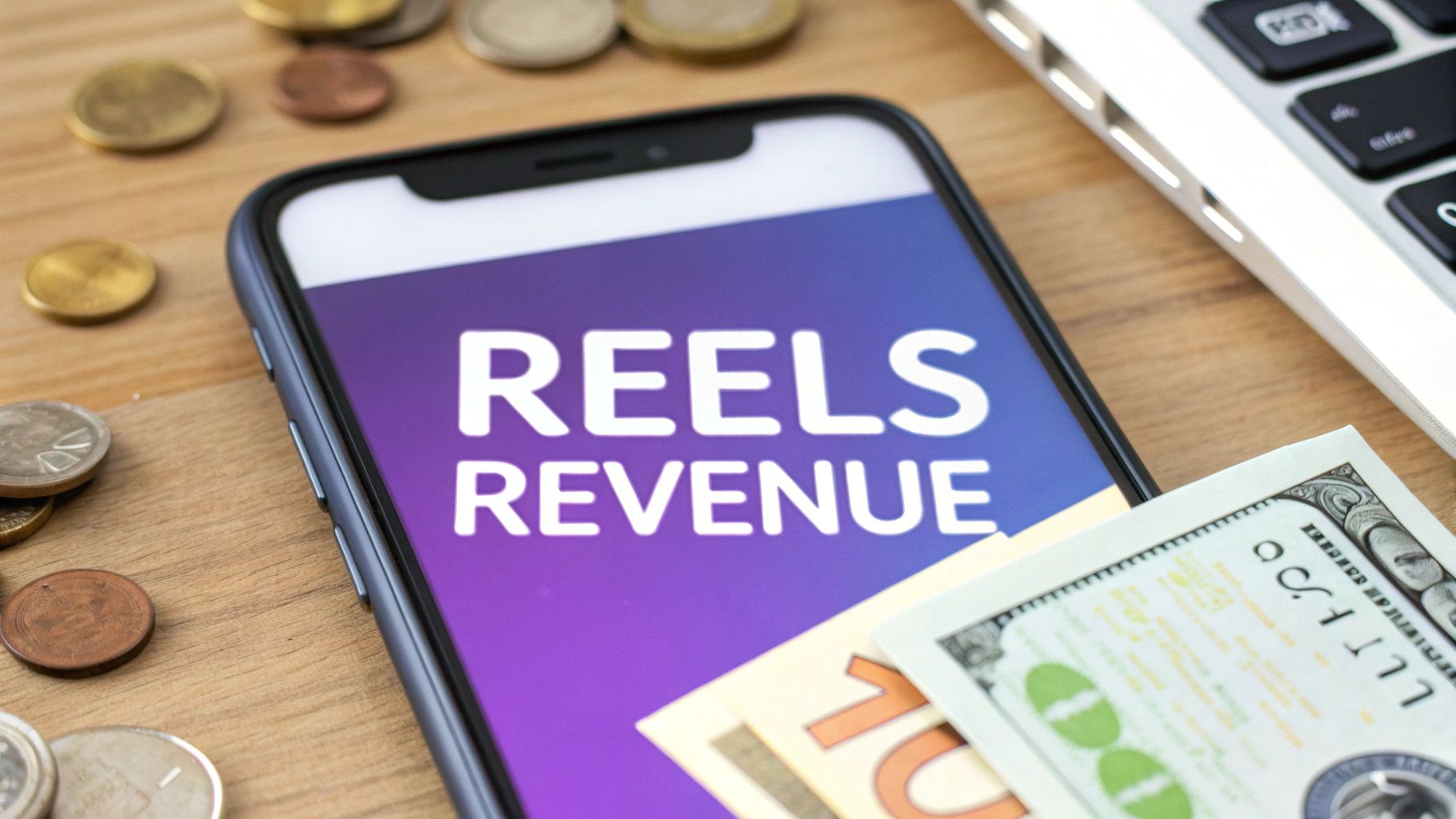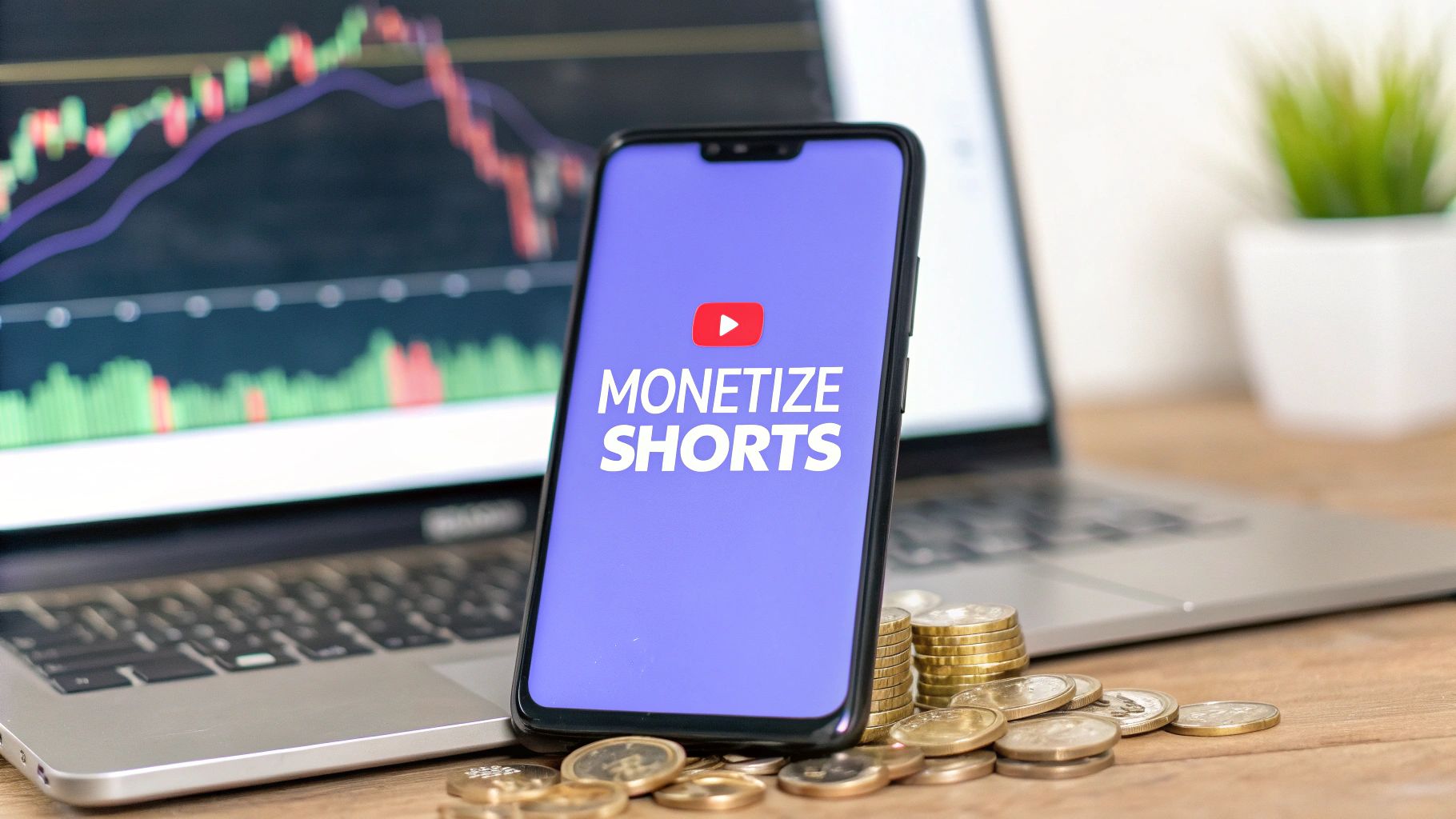Making a video with AI is surprisingly straightforward. You start with a script, feed it into a text-to-video tool like Sprello to generate the visuals and voiceover, and then you just assemble and edit the final pieces. The whole process sidesteps the need for cameras, actors, or complicated software, letting pretty much anyone create professional-looking content in just a few minutes.
Why AI Is Changing Video Creation Forever
Welcome to the new world of video production—one where you don't need a film crew to bring your ideas to life. AI video tools are a game-changer for creators, marketers, and businesses, making it possible to produce high-quality videos way faster and cheaper than the old-school way.
This guide will walk you through the entire workflow, step-by-step. We'll cover everything from hammering out a script and generating visuals to adding voiceovers and making those final tweaks. Forget about intimidating software and expensive gear; we're going to show you how AI puts professional-grade video within everyone's reach, opening up a ton of creative potential and saving you a massive amount of time.
This isn't just a small trend, either. It's a huge market shift. The global AI video market is already valued at USD 7.6 billion and is expected to rocket to USD 156.57 billion in the next few years. That’s a compound annual growth rate of over 35%, which shows just how much people want these kinds of automated, efficient video tools.
The New Creative Workflow
Think about the traditional way of making videos: scripting, filming, editing, post-production... it’s a long, expensive grind. AI completely flips that model on its head by automating the most painful parts. Instead of worrying about cameras and locations, you're more like a director guiding an AI.
Your main job is to give clear, descriptive instructions. From there, the AI does the heavy lifting—turning your text prompts into visuals, your script into a natural-sounding voiceover, and even finding music that fits the vibe you're going for.
This workflow visual breaks down the core steps, from the initial script to the final polished video.
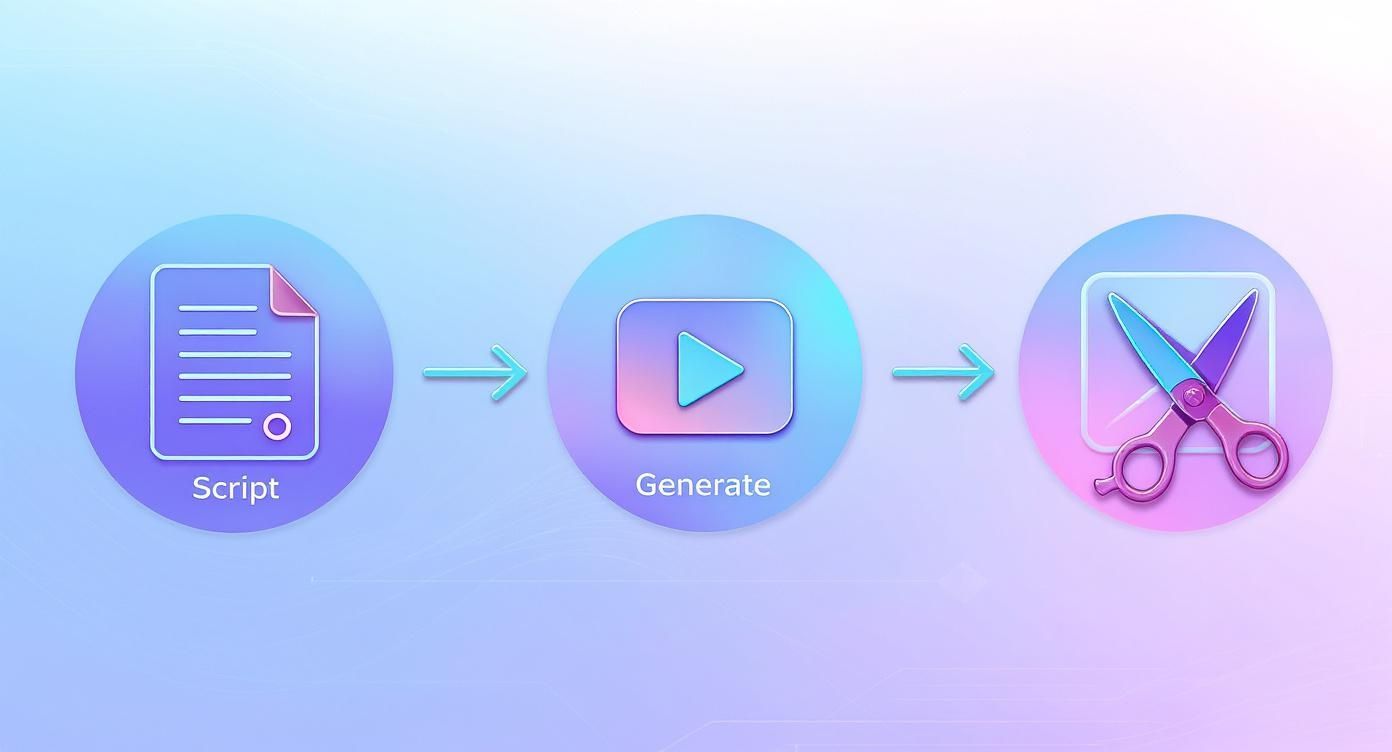
As you can see, the process gets boiled down to three main phases, which makes the whole thing a lot less overwhelming.
High-Quality Video for Everyone
Maybe the biggest win with AI is how it levels the playing field. A small business or a solo creator can now produce content that used to require a full-on production studio and a five-figure budget.
This brings a few major advantages:
- Speed: You can whip up a social media ad or an explainer video in a matter of hours, not weeks.
- Cost Savings: Say goodbye to huge bills for equipment, actors, and location rentals.
- Scalability: Want to test a dozen different video ideas to see what your audience likes? Now you can, without a massive upfront investment.
The real superpower here is creative velocity. You can go from a simple idea to a finished video faster than ever before. This speed allows for way more experimentation and lets you fine-tune your marketing on the fly.
To really get a handle on what's possible, it’s worth checking out the best AI tools for content creators on the market right now. Knowing what tools are out there is the first step toward building a smart, AI-driven video strategy. The future of video isn't about replacing human creativity; it's about amplifying it with powerful, easy-to-use tech.
Finding the Right AI Video Generator for Your Project
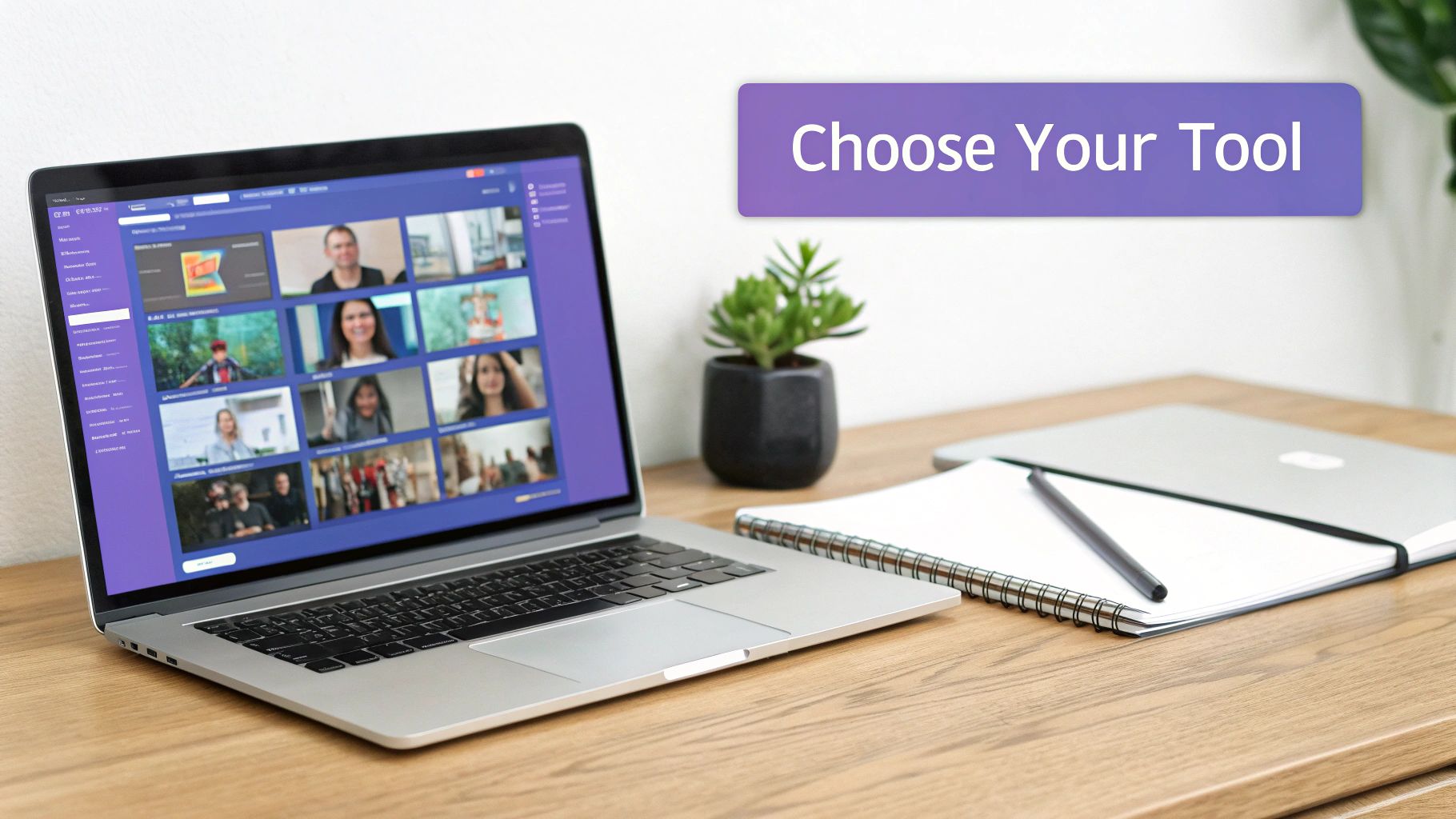
Before you can start creating, you need the right tools. The world of AI video generators is exploding, and trying to pick the best one can feel like a full-time job. The secret isn't finding the tool with the most hype; it's about matching the right platform to the job you actually need to get done.
This isn't just about grabbing any tool—it's about finding your tool. Are you trying to whip up a professional training video using an AI presenter? Or are you aiming for a cinematic, jaw-dropping ad generated purely from a text prompt? The best choice for one is almost never the best for the other.
This massive interest is fueling a booming market. The global AI video generator space was valued at around USD 534.4 million and is expected to rocket to USD 2.56 billion soon. That's a huge leap, driven by teams in marketing, training, and content creation jumping on board. For you, this means more incredible options, but also a lot more noise to cut through.
Different Tools for Different Jobs
The first thing to do is get your head around the main categories of AI video generators out there. Each type is built for a different purpose, so understanding the landscape is key to making a smart choice.
- Text-to-Video Generators: These are the ones grabbing all the headlines. You write a descriptive prompt—something like, "a golden retriever chasing a red ball through a field at sunset"—and the AI conjures up a video clip from thin air. They're fantastic for creative storytelling, ads, and social media content where you need truly unique visuals.
- Avatar-Based Generators: These platforms are your go-to for presentations, e-learning modules, and corporate updates. You pick a realistic AI avatar, paste in your script, and the avatar delivers it on screen. It’s an incredibly efficient way to create professional-looking training videos without a camera or a human presenter.
- AI-Powered Editing Suites: This is where tools like Sprello shine. They blend AI generation features with a classic video editing timeline, giving you the best of both worlds. You can generate B-roll, voiceovers, and images with AI, then seamlessly assemble them with your own footage in a user-friendly editor. This is easily the most flexible option for most marketing and content teams.
Key Features to Look For
Once you've figured out what type of tool you need, you can start digging into the specific features. Not all platforms are built the same, and a few key capabilities can make or break your entire workflow.
Here’s a quick comparison to help you see how the different types of tools stack up. This isn't about which is "best" overall, but which is best for a specific task.
AI Video Tool Feature Comparison
| Feature | Text-to-Video (e.g., Sora, Pika) | Avatar-Based (e.g., Synthesia) | Editing Suite (e.g., Sprello) |
|---|---|---|---|
| Primary Use Case | Creative and cinematic visuals | Presentations and training videos | All-in-one marketing and social content |
| Visual Style Control | High control via descriptive prompts | Limited to pre-set avatars/backgrounds | High flexibility with generated assets |
| Voice Cloning | Often included for voiceovers | High-quality, multi-language support | Integrated with premium voice models |
| Character Consistency | A major challenge; requires skill | Excellent; the same avatar is used | Can be managed within the editor |
As you compare, think about what you’ll be doing day-to-day. If you’re cranking out a ton of product demos, a tool with strong editing and asset management is non-negotiable. For a deeper dive on that, check out our guide on finding the best product video generator.
The goal is to find a platform that not only fits your creative vision but also streamlines your production process. The right tool should feel like an assistant that handles the technical heavy lifting, freeing you up to focus on the story you want to tell.
Ultimately, your choice will come down to your budget, your team's technical comfort level, and the kind of videos you need to make. The good news? Most of these platforms offer free trials. My best advice is to get your hands dirty. Spend an afternoon testing a few options to see which one feels intuitive and delivers the results you’re after. Nothing beats a little hands-on experience to find a tool that will become a core part of your creative toolkit.
Scripting and Storyboarding for an AI Director
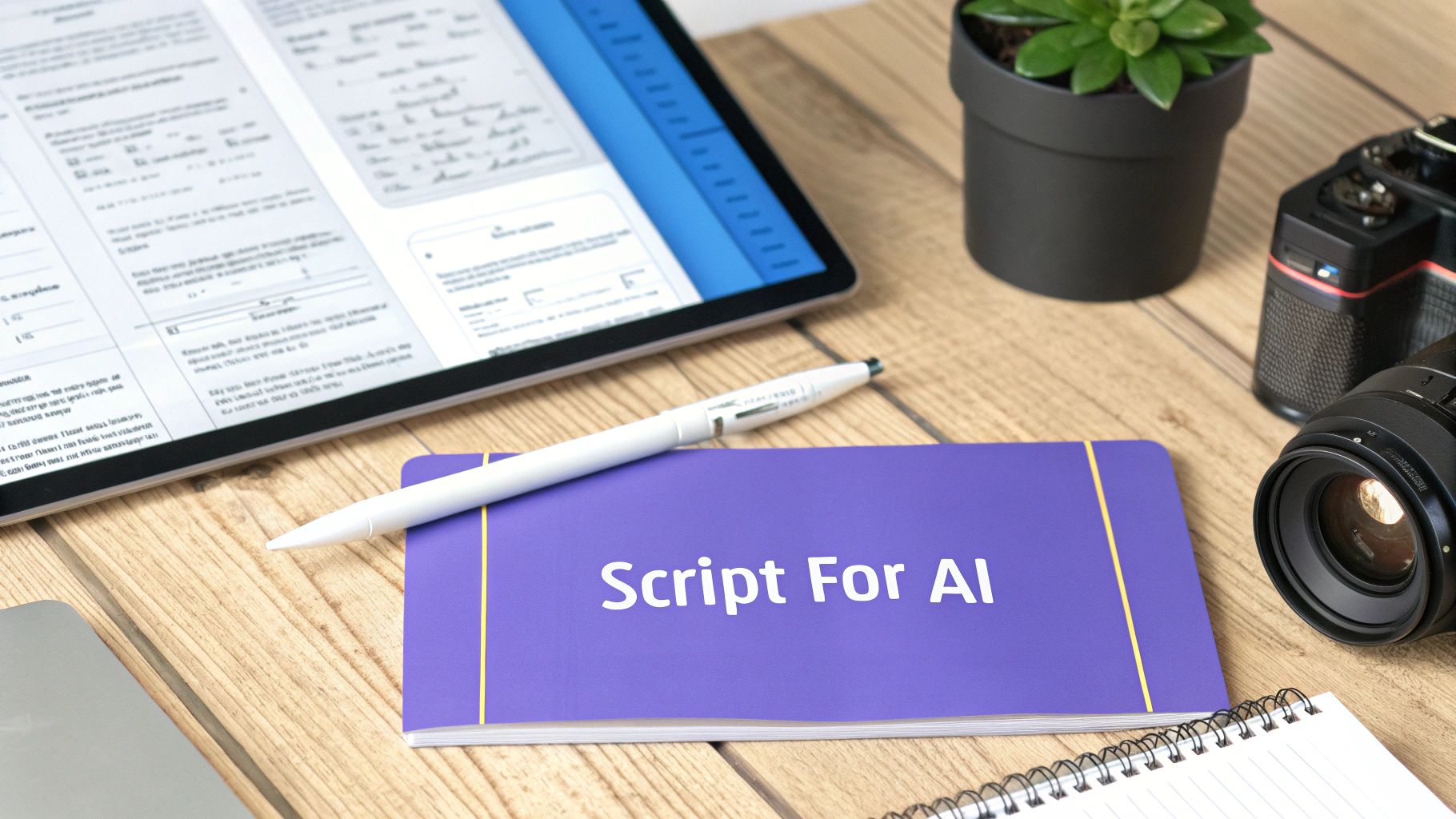
Every great video starts with a solid script. That’s a given. But when you’re working with AI, your script pulls double duty. It's not just the narrative blueprint; it’s the direct instruction manual for your AI "director," "cinematographer," and "actor," all rolled into one. The words you choose will literally build the world the AI generates.
Think about it like this: a human director can read "a tense office scene" and fill in the blanks with their own experience. An AI can't. It needs you to spell it out. What time of day is it? Is the furniture modern or classic? What emotion is on the character’s face? What specific camera angle are you picturing?
I can’t stress this enough: the more detail you pack into your script, the closer the final video will be to what you envisioned. This initial planning stage is where you win or lose the battle for a great AI video. Rushing it is a surefire way to end up with a collection of generic, disjointed clips.
From Vague Idea to Actionable Script
Before you even think about writing a prompt, you need to nail down your core idea. What's the one thing you absolutely need your audience to understand or feel? Are you teaching them something, showing off a product, or telling a compelling story?
Once you have that central message, you can start building a story around it. Even for a quick 30-second ad, a simple three-act structure is your best friend:
- The Hook: Kick things off with something that grabs immediate attention—a sharp question, a surprising visual, or a bold statement.
- The Middle: This is where you deliver the goods. Present the main information, show the problem your product solves, or develop your narrative.
- The Call to Action (CTA): End with a clear, direct instruction. Tell the viewer exactly what you want them to do next.
Let's say you're making a video for a new productivity app. Your structure might be as simple as:
- Hook: "Feeling completely buried by your to-do list?"
- Middle: Show visuals of the app effortlessly organizing tasks, with a character looking relieved and in control.
- CTA: "Download now and finally reclaim your day."
This framework gives you a strong foundation to build upon. For more inspiration, checking out a detailed https://sprello.ai/blog/advertisement-script-example can be a huge help in seeing how these pieces come together in a real-world marketing video.
Writing for a Visual AI
Now it’s time to translate that structure into a script the AI can actually work with. This means splitting your script into two distinct parts for every scene: the visual prompt (what the AI creates) and the narration (what the audience hears).
The visual prompt is where the magic really happens. It needs to be loaded with sensory details. Don't just say "a person working." Get cinematic with it.
Pro Tip: Treat your prompt like a command to a digital filmmaker. Be explicit about the camera angle, the lighting, and the overall mood. The difference between "a car driving" and "a sleek black sports car on a wet city street at night, neon lights reflecting on its hood, close-up shot of the front wheel" is everything.
As you develop your script, consider using AI voice-to-text tools to capture your ideas. Sometimes, speaking the dialogue out loud and transcribing it helps you find a more natural-sounding rhythm for your narration.
Creating a Simple Shot List
A shot list—or a basic storyboard—is your video's roadmap. It breaks down the entire project scene by scene, ensuring everything flows logically. You don't need fancy software; a simple table gets the job done perfectly.
This plan is also your best defense against one of the biggest headaches in AI video creation: maintaining visual consistency.
Here’s a basic template you can run with:
| Scene # | Visual Prompt | Narration / Dialogue |
|---|---|---|
| 1 | A wide shot of a messy, cluttered home office. A woman in her 30s with short brown hair sits at the desk, looking stressed and overwhelmed by stacks of paper. Soft, morning light from a window. | "Is your workday feeling more chaotic than productive? You're not alone." |
| 2 | Close-up shot of the same woman's face, a look of frustration. She sighs heavily. | "Trying to manage everything at once can be exhausting." |
| 3 | A dynamic shot showing a smartphone screen with a clean, organized app interface. The woman’s hand swipes through completed tasks. Bright, optimistic visuals. | "Introducing a smarter way to organize your life." |
See how the character description—"woman in her 30s with short brown hair"—is included in the prompt for each scene? That simple, repetitive detail dramatically increases the odds of the AI generating a consistent-looking character. This kind of meticulous planning is the secret to making an AI video that doesn’t just look cool, but actually tells a clear and compelling story.
Bringing Your Vision to Life with AI Generation
With your script and storyboard locked in, it's time for the fun part: making everything real. This is where your written ideas transform into actual sights and sounds. Think of yourself as a director guiding a team of specialized AIs to produce the raw materials for your final video.
https://www.youtube.com/embed/IjF5Uun2jrM
Your main job here is to generate the three core pieces for every scene on your storyboard: the visual clips, the voiceover, and the background music. Each requires a slightly different touch, but they all hinge on giving the AI clear, specific instructions.
Let's walk through how to create and organize each of these assets, one by one.
Crafting Prompts for Stunning Visuals
Getting great-looking video clips from AI is all about the art of the prompt. While your script's visual notes are a good starting point, you'll need to flesh them out to get the AI to see what you see. The trick is to be descriptive without boxing the AI in too much.
For instance, your storyboard might just say, "a woman in her 30s with short brown hair sits at a desk, looking stressed." That's okay, but we can do better.
A much more effective prompt would be: "Photorealistic shot, a woman in her 30s with short brown hair sits at a cluttered office desk, looking stressed and overwhelmed. Soft morning light from a window. Cinematic, shallow depth of field."
See the difference? We added key details that guide the AI:
- Style: "Photorealistic" and "cinematic" set the overall aesthetic.
- Lighting: "Soft morning light" creates a specific mood.
- Camera Work: "Shallow depth of field" gives it a professional, polished feel.
Don't be afraid to experiment. Try phrases like "animated explainer video," "vintage 16mm film," or "vibrant, high-energy marketing video" to find the perfect style for your project.
The Challenge of Character Consistency
One of the biggest hurdles in AI video creation is making sure your characters look the same from one shot to the next. It’s incredibly jarring for a viewer when the main character suddenly looks like a different person. This instantly breaks the illusion.
The most reliable way to solve this is through repetition. You have to use the exact same descriptive phrases for your character in every single prompt.
If you decide your character is "a man in his 40s with a graying beard, wearing a blue plaid shirt and glasses," then that entire phrase has to be in every prompt where he appears. Even a tiny change can make the AI generate someone completely different.
This same logic applies to your locations. If your scene is in "a bright, minimalist kitchen with white cabinets and a marble countertop," use those exact words every time. Meticulous repetition is what creates consistency.
Generating Professional AI Voiceovers
Once your visuals are ready, it's time to give your video a voice. Modern text-to-speech (TTS) AI has come a long way from those old, robotic voices. Today’s tools can create incredibly natural-sounding narration filled with emotion and personality.
Most AI video creation tools, like Sprello, have voice generation built right in. You just paste your script for a particular scene, pick a voice that fits your brand’s vibe, and let the AI do the work.
Here are a few tips I've learned for getting great audio:
- Find the Right Voice: Don't just settle for the default. Listen to a bunch of options. Does your video need an authoritative tone? Or something more friendly and energetic? The right voice makes a huge difference.
- Use Punctuation as a Director: The AI reads punctuation for cues on pacing and inflection. A simple comma creates a natural pause that can add emphasis just where you need it.
- Generate in Small Chunks: Instead of creating one giant audio file for the whole script, generate the voiceover scene-by-scene, or even sentence-by-sentence. This gives you way more control in the editing room when you need to time the narration perfectly with the visuals.
Finding the Perfect AI-Generated Music
The final piece of the puzzle is the soundtrack. Music does the heavy lifting for the emotional tone of your video, setting the mood and driving the pace. Digging through stock music sites is a classic time-sink, but AI music generators can create a custom track in minutes.
These tools let you dream up royalty-free music from a simple text prompt. You can call out the genre, mood, tempo, and even specific instruments.
Here’s how you might prompt for different kinds of videos:
| Video Type | AI Music Prompt |
|---|---|
| Tech Product Ad | "Uplifting, inspiring corporate track with a driving electronic beat and piano melody. Optimistic and modern." |
| Cozy Cafe Promotion | "Gentle, acoustic folk music with soft guitar strumming and a warm, relaxing feel. Slow tempo." |
| Fitness App Ad | "High-energy, motivational electronic dance music (EDM) with a strong bassline. Fast-paced and powerful." |
Just like with visuals, the more descriptive you are, the better. Generate a few different tracks and play them against your video clips to see what clicks. A custom score helps your video feel unique and professional, giving you all the raw materials you need to head into the final edit.
Assembling and Polishing Your Final Video
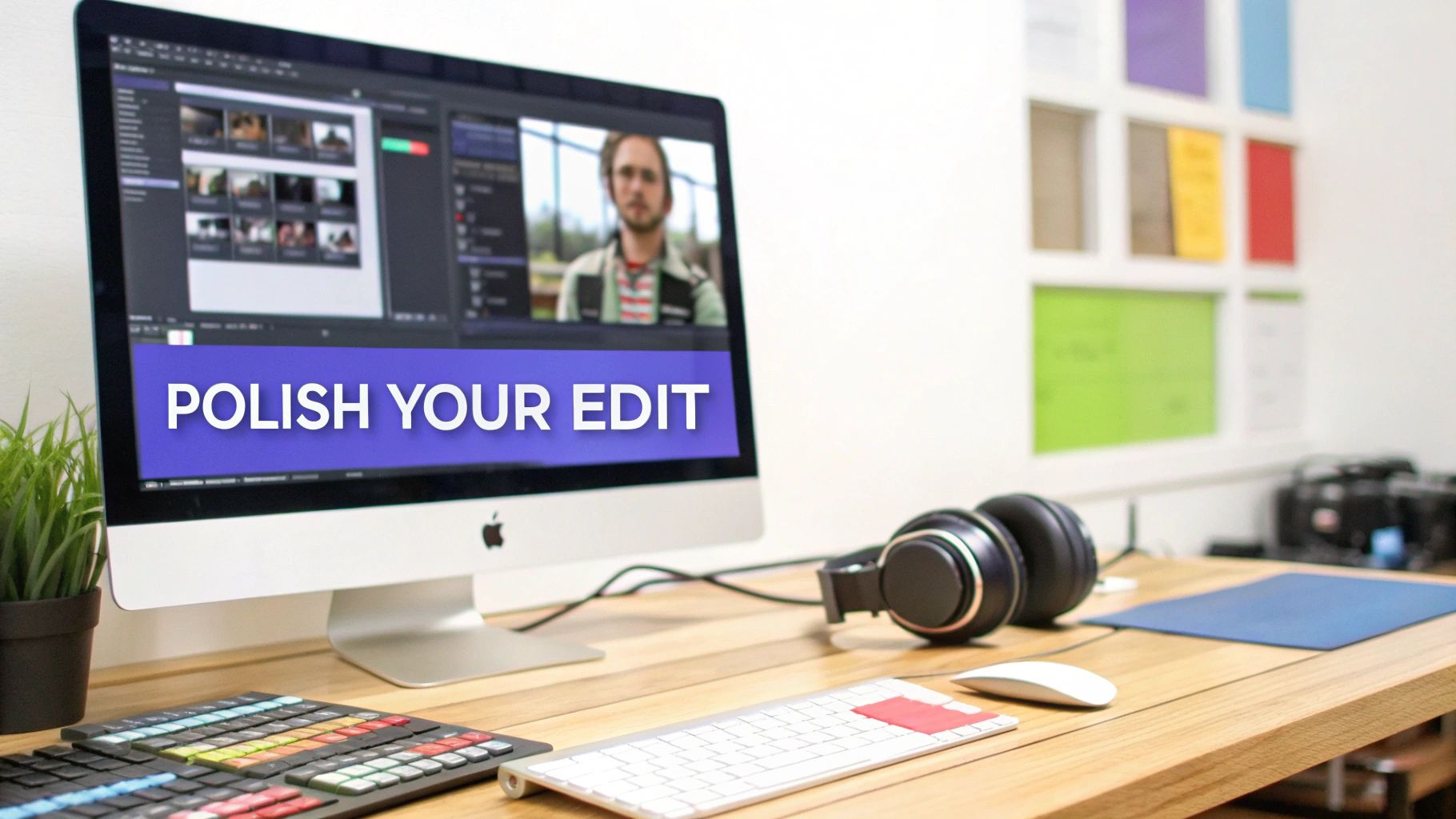
Okay, you've generated all your clips, voiceovers, and music. That’s a huge step, but we’re not quite at the finish line. Now comes the fun part: taking that folder of raw assets and weaving it all into a cohesive, professional-looking video. This is where your story truly comes together.
The editing stage is where you get to set the pace, fine-tune the emotional tone, and make sure your message hits home. It might sound a bit technical, but modern AI-powered platforms make this process surprisingly intuitive. You don't need to be a seasoned editor; you just need a clear vision for how you want the final video to feel.
From Asset Folder to Video Timeline
The first thing you’ll do is get all your generated assets—the video clips, voice tracks, and music—into your editing timeline. If you’re using a tool like Sprello, this is a breeze since everything is already in one place. Your goal here is to arrange the clips according to your storyboard, basically building the skeleton of your narrative.
Once the clips are in order, start trimming. I’ve found that almost every AI-generated clip has a few extra frames or seconds at the beginning or end. Snipping these off creates a much tighter, more professional feel and really helps with the overall pacing.
This is also the perfect time to think about transitions between scenes. A simple cut often works best, but a subtle fade or a smooth slide can connect two different ideas more gracefully. Just a word of caution: don't go overboard. A few well-placed transitions are far more effective than a video cluttered with distracting effects.
Letting AI Handle the Heavy Lifting
Modern editing isn't just about manually cutting and pasting anymore. The ecosystem of AI-driven video editing tools is exploding—in fact, 77% of video editing software now includes some form of AI automation. These tools are built to handle the tedious work, letting you focus on the creative side of things.
These features can be a massive time-saver. For instance, some platforms have tools that can automatically identify and remove awkward silences in your voiceover track. Others can even suggest the best B-roll clip from your library to match a specific line of narration. It’s a game-changer for making videos with AI more efficiently.
The real magic of AI in editing is how it tackles the repetitive, time-consuming tasks. It frees you up to focus on storytelling, pacing, and emotional impact—the stuff a machine just can't replicate.
For anyone looking to really dig into this, our guide on automatic video editing takes a much deeper look at how these tools can seriously speed up your workflow.
The Final Polish: Audio and Text
With your visuals all sequenced, it's time to perfect the audio. This means mixing your audio layers—voiceover, music, and any sound effects—so they complement each other instead of competing for attention.
Here's my approach:
- Voiceover First: Your narration is the star of the show. I always set its volume first to make sure every word is crisp and easy to understand.
- Music as a Backdrop: The background music sets the mood, but it should never overpower the voice. I usually duck its volume so it sits comfortably underneath the narration.
- Sound Effects for Emphasis: Use sound effects sparingly to highlight key moments—think a subtle "swoosh" for a text reveal or a "click" for an on-screen action.
Finally, add the text elements that will make your video more engaging and accessible. This includes a clear title card at the start, lower thirds to introduce speakers or topics, and a call-to-action slide at the end.
And most importantly: add captions. A huge number of social media videos are watched with the sound off, which makes synchronized captions an absolute must. Many AI editors can automatically transcribe your voiceover and generate these for you, saving you a ton of time and ensuring your message reaches the widest possible audience. This last layer of polish is what truly separates a good video from a great one.
Common Questions About Making Videos with AI
When you first dive into making videos with AI, you're going to have questions. It's only natural. Understanding the workflow is one thing, but dealing with the quirks of the technology in a real project is another.
Let's get straight to the answers for the questions I hear most often from people just starting out. This should help you set the right expectations and feel more prepared for any bumps in the road.
How Long Does It Take to Make a Video with AI?
This is the big one, and the honest answer is: it really depends on what you're making. You could whip up a simple, one-minute video with a stock AI avatar and a script you already have in under an hour. This is fantastic for quick social media clips or internal company updates where you just need to get something out fast.
On the other hand, if you're aiming for something more cinematic—a piece that needs dozens of unique AI-generated clips, careful editing, and a custom score—you could easily spend several hours on it. The real time-saver is that you don't have to film anything. Just remember that the creative parts, like scripting and editing, still need your time and attention.
Can I Use AI-Generated Videos for My Business?
For the most part, yes, you absolutely can. But you have to check the fine print. Most reputable paid platforms, like Sprello, give you a full commercial license for anything you create. That means you're clear to use the videos in your ads, on your website, or for any other business need.
Always, always read the terms of service for the tool you're using. Free versions or beta programs sometimes have restrictions on commercial use, so you need to know what you can and can't do before you hit publish.
How Do I Keep Characters Looking the Same in AI Videos?
Ah, the consistency problem. This is one of the trickiest parts of AI video right now. The best way to manage it is to be incredibly specific and repetitive with your prompts.
Don't just ask for "a man." Instead, describe him as "a man in his 40s with a short graying beard and a red flannel shirt" every single time you generate a scene with him. Being redundant is your best strategy. We're also starting to see tools add features that let you "lock" a character's look for a whole project, which will be a game-changer.
What Are the Current Limitations of AI Video Tools?
AI video has come a long way, fast, but it’s not perfect. You’ll still run into some limitations. Today’s tools can sometimes get tripped up by complex or subtle movements, like natural-looking hand gestures, and you might see weird visual artifacts from time to time.
Things like perfect lip-syncing and keeping a character looking exactly the same during fast-paced action are still a challenge. The good news? The tech is getting better every few months. The developers know these are the pain points, and every update seems to tackle them head-on.
Ready to skip the learning curve and just start creating? Sprello is an all-in-one platform that takes you from a simple script to a finished video in minutes. Generate your first AI video for free.
